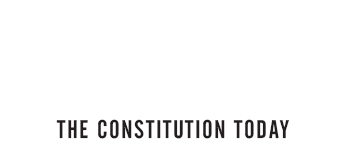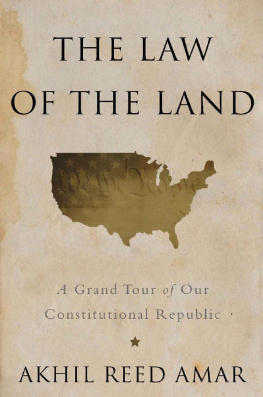
ALSO BY AKHIL REED AMAR

The Law of the Land
Americas Unwritten Constitution
Americas Constitution: A Biography
The Bill of Rights: Creation and Reconstruction
The Constitution and Criminal Procedure

Copyright 2016 by Akhil Reed Amar
Published by Basic Books,
An imprint of Perseus Books, a division of PBG Publishing, LLC, a subsidiary of Hachette Book Group, Inc.
All rights reserved. Printed in the United States of America. No part of this book may be reproduced in any manner whatsoever without written permission except in the case of brief quotations embodied in critical articles and reviews. For information, address Basic Books, 250 W. 57th St, 15th floor, New York, NY 10107.
Books published by Basic Books are available at special discounts for bulk purchases in the United States by corporations, institutions, and other organizations. For more information, please contact the Special Markets Department at the Perseus Books Group, 2300 Chestnut Street, Suite 200, Philadelphia, PA 19103, or call (800) 810-4145, ext. 5000, or e-mail .
Designed by Trish Wilkinson
Set in 10.5-point Goudy Oldstyle STD
Library of Congress Cataloging-in-Publication Data
Names: Amar, Akhil Reed, author.
Title: The constitution today: timeless lessons for the issues of our era / Akhil Reed Amar.
Description: New York: Basic Books, 2016. | Includes bibliographical references and index.
Identifiers: LCCN 2016023102 (print) | LCCN 2016023606 (ebook) | ISBN 9780465096343 (e-book)
Subjects: LCSH: Constitutional lawUnited States. | BISAC: LAW / Constitutional. | HISTORY / United States / General. | POLITICAL SCIENCE / Government / General. | LAW / Essays.
Classification: LCC KF4550 .A728 2016 (print) | LCC KF4550 (ebook) | DDC 342.73dc23
LC record available at https://lccn.loc.gov/2016023102
10 9 8 7 6 5 4 3 2 1
For Bob Woodward
journalist and historian, mentor and mensch
Contents
ON THE MORNING OF JUNE 28, 2012, the eyes of the world turned to the United States Supreme Court for what many thought might be the biggest constitutional ruling of the decade. Would the justices uphold or strike down the sweeping 2010 health-insurance law known as Obamacare? In particular, would the Court undermine the statutes cornerstone clausethe so-called individual mandaterequiring a wide swath of Americans to procure subsidized health-insurance policies or else pay substantial tax penalties? And if the Court did invalidate the signature domestic accomplishment of Americas first black president, would this epic judicial rebuke doom Barack Obamas prospects for reelection in November? Having delivered the presidency on a silver platter to the Republican candidate in the notorious Bush v. Gore ruling in 2000, would a bare majority of Republican-appointed justices in effect do this again in 2012and in the process erase the biggest consequence of the Democrats intervening sweep in 2008?
Network cameras are not allowed in the decorous courtroom itself. Thus, as Chief Justice John Roberts began an oral summary of his ruling on behalf of a closely divided Court, television correspondents outside the courthouse were furiously speed-reading copies of the chiefs simultaneously released, and quite lengthy, written opinion. On CNN, which bills itself as the most trusted name in news, a historic headline appeared on-screen at 10:07 Eastern Time: BREAKING NEWS: SUPREME CT. KILLS INDIVIDUAL MANDATE. Over the next couple of minutes, CNNs John King breathlessly explained to the world what this all meant: The Court striking down that mandate is a dramatic blow to the policy and to the president, politically.... The justices have just gutted... the centerpiece provision of the Obama health-care law.... Without a doubt,... the justices throwing that out is a direct blow to the president of the United States, a direct blow to his Democratic party. As King spoke, the network posted another headline at 10:09: INDIVIDUAL MANDATE STRUCK DOWN: Supreme Court finds measure unconstitutional.
Meanwhile, Fox News was broadcasting its own headline: SUPREME COURT FINDS HEALTH CARE INDIVIDUAL MANDATE UNCONSTITUTIONAL. Standing on the courthouse steps at 10:08, with a copy of the Roberts opinion in her excited hands, correspondent Shannon Bream minced no words: The mandate is gone!
Among the millions of real-time onlookers was President Obama himself, who was watching the coverage of multiple networks in the outer Oval Office. Like so many others in that instant, he was getting his information from broadcast journalists, who were telling him that his proudest legislative achievement was kaput.
BUT IT WASNT. The journalists had blundered, badly. In their rush to get it first, they got it wrong. They hadnt even read to the end of the Roberts opinion before they started summarizing it, erroneously, on camera. Haste in those supercharged seconds was not their only lapse. In the months leading up to that fateful day, many prominent journalists had failed to understand that Obamacares individual mandate could be constitutionally sustained on either an interstate-commerce clause theory or a tax-clause theory. Had reporters and pundits grasped this basic legal fact about the case, they would have realized, as Roberts began narrating his opinion and they began flipping through it, that the chief justices early pages were addressing only the former theory. No matter what those pages said, Obamacare could be upheldas in fact it was upheld that day, as we all know nowon the latter theory.
The networks spectacular goofs that morning remind us of two large truths about journalism. First, most professional journalists are not experts on constitutional law. Second and related, almost all journalists, by definition, act under severe time pressure. They act on deadline.
The very word journalist, from the French jour, captures the immediacy of the daily news and the oft-fleeting nature of the journalists message. The unrelenting need to attend quickly to whatever the issue du jour might be makes it hard for the ordinary journalist to acquire genuine mastery of any single subject requiring long studywhether that subject be American constitutional law or anything else. At one time, printing presses and delivery trucks dictated journalisms tight schedules. Today, there remains the driving desire to get there first, to scoop the competition, if only by a few minutes or even seconds. This furious obsession with fastness and firstness makes a certain sense, given journalists self-imagethey are newspeople, not oldspeopleand the medias current business model. As headlines about Obamacare flashed across television screens, so did running Dow and S&P tickers. Ours is a world of continuous and instantaneous buying and selling of virtually everything, everywhere. Any news outlet that is just a hair ahead of the rest of the market on a colossal news item might help some savvy trader somewhere make a killing.
In obvious contrast to a typical newspaper essay or TV news show designed for immediate consumption, Americas Constitution has a protracted shelf life. As Chief Justice John Marshall famously observed in the 1819 case of McCulloch v. Maryland, our Constitution aspires to endure for ages to come.
Next page










